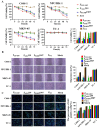Axl and EGFR Dual-Specific Binding Affibody for Targeted Therapy in Nasopharyngeal Carcinoma
- PMID: 39594573
- PMCID: PMC11592995
- DOI: 10.3390/cells13221823
Axl and EGFR Dual-Specific Binding Affibody for Targeted Therapy in Nasopharyngeal Carcinoma
Abstract
Nasopharyngeal carcinoma (NPC) is a tumor of the head and neck, with a higher incidence in southern China and Southeast Asia. Radiotherapy and chemotherapy are the main treatments; however, metastasis and recurrence remain the main causes of treatment failure. Further, the majority of patients are diagnosed in the late stage due to lack of tumor-specific biomarker for early diagnosis. Therefore, an effective treatment and early detection can improve the outcome of patient with NPC. Axl and EGFR are co-expressed in NPC tissues and play key roles in tumor proliferation, migration, and invasion, which are often correlated with poor prognosis and therapy resistance. In this study, we generated a novel bispecific affibody (Z239-1907) for the dual targeting and inhibition of Axl and EGFR expression in NPC-positive cells both in vitro and in vivo. The in vitro experiments demonstrated that Z239-1907 had more pronounced antitumor effects than either modality alone (ZAXL239 or ZEGFR1907) in NPC-positive cells. Further, mice bearing NPC-positive tumors showed significant inhibition in tumor growth after treatment with Z239-1907 compared to ZAXL239 and ZEGFR1907. The in vivo tumor targeting ability and imaging also showed that Z239-1907 specifically and selectively targeted NPC xenograft mice models and accumulate at tumor site as early as 30 min and disappeared within 24 h post-injection. Collectively, these results suggest that Z239-1907 dual-target affibody is a promising therapeutic agent and a molecular imaging probe for early diagnosis in NPC.
Keywords: Axl; EGFR; affibody molecules; nasopharyngeal carcinoma; targeted therapy.
Conflict of interest statement
The authors declare no conflicts of interest.
Figures







Similar articles
-
Function of AXL and molecular mechanisms in regulation of nasopharyngeal carcinoma.Zhong Nan Da Xue Xue Bao Yi Xue Ban. 2022 Jun 28;47(6):685-697. doi: 10.11817/j.issn.1672-7347.2022.210786. Zhong Nan Da Xue Xue Bao Yi Xue Ban. 2022. PMID: 35837768 Free PMC article. Chinese, English.
-
A specific super-enhancer actuated by berberine regulates EGFR-mediated RAS-RAF1-MEK1/2-ERK1/2 pathway to induce nasopharyngeal carcinoma autophagy.Cell Mol Biol Lett. 2024 Jun 28;29(1):92. doi: 10.1186/s11658-024-00607-4. Cell Mol Biol Lett. 2024. PMID: 38943090 Free PMC article.
-
Novel affibody molecules targeting the AXL extracellular structural domain for molecular imaging and targeted therapy of gastric cancer.Gastric Cancer. 2025 Mar;28(2):174-186. doi: 10.1007/s10120-024-01568-5. Epub 2024 Dec 7. Gastric Cancer. 2025. PMID: 39644434 Free PMC article.
-
Anti-EGFR therapies in nasopharyngeal carcinoma.Biomed Pharmacother. 2020 Nov;131:110649. doi: 10.1016/j.biopha.2020.110649. Epub 2020 Aug 21. Biomed Pharmacother. 2020. PMID: 32836074 Review.
-
A Canadian Perspective on Systemic Therapy for Recurrent or Metastatic Nasopharyngeal Carcinoma.Curr Oncol. 2025 Jan 17;32(1):48. doi: 10.3390/curroncol32010048. Curr Oncol. 2025. PMID: 39851964 Free PMC article. Review.
References
-
- Jacob J.B., Jacob M.K., Parajuli P. Review of immune checkpoint inhibitors in immuno-oncology. Adv. Pharmacol. 2021;91:111–139. - PubMed
-
- Burton E.M., Tawbi H.A. Bispecific Antibodies to PD-1 and CTLA4: Doubling Down on T Cells to Decouple Efficacy from Toxicity. Cancer Discov. 2021;11:1008–1010. doi: 10.1158/2159-8290.CD-21-0257. - DOI - PubMed
Publication types
MeSH terms
Substances
Grants and funding
LinkOut - more resources
Full Text Sources
Research Materials
Miscellaneous

